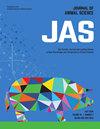Effects of dietary supplementation with linseed oil, Ascophyllum nodosum or treated A. nodosum on animal performance, gaseous emissions, ruminal fermentation and microbiota, and meat quality in growing dairy beef bulls
IF 2.7
2区 农林科学
Q1 AGRICULTURE, DAIRY & ANIMAL SCIENCE
引用次数: 0
Abstract
Oils high in polyunsaturated fatty acids (PUFA) and seaweeds containing phlorotannins have potential anti-methanogenic effects in ruminants. This study assessed the potential of dietary supplementation with linseed oil, Ascophyllum nodosum or treated A. nodosum in an intensive beef cattle feeding system on animal performance, gaseous emissions, ruminal fermentation and microbiota, and muscle fatty acid profiles. Seventy-two dairy-beef bulls (380 kg; 11 months of age) were randomly allocated to one of four dietary treatments (n = 18) for a 70-d period. The diet consisted of a 60:40 grass silage:concentrate ratio. Silage was offered daily (0900 h) and concentrates were offered twice daily (0800 h and 1500 h). Dietary treatments were incorporated into the concentrate portion of the diet as follows; 1) CON (no supplementation), 2) LSO (linseed oil), 3) SW (A. nodosum) and 4) EX (A. nodosum extract), included to target 0, 4, 2 and 2% of dry matter intake (DMI), respectively. The concentrates were formulated to be isonitrogenous across the four treatment groups. Total DMI (American Calan Inc., Northwood, NH), average daily gain (ADG), gain:feed and enteric emissions (GreenFeed; C-Lock Inc., Rapid City, SD) were measured for the 70-d supplementation period. Total DMI (P = 0.17), ADG (P = 0.28), gain:feed (P = 0.68) and total tract digestibility (P = 0.70) did not differ across treatments. Daily methane production (P < 0.001) for CON, LSO, SW and EX was 210, 170, 202 and 193 g/d, respectively, resulting in reductions of 19 and 8% for LSO and EX, respectively, relative to CON. Ruminal fermentation parameters show that LSO was the only dietary treatment to increase propionate (P = 0.09) and decrease butyrate (P = 0.04) concentrations relative to CON. Microbial analyses showed LSO supplementation increased and decreased relative abundances of fungal genera Buwchfawromyces and Piromyces, respectively, while altering relative abundances of the bacterial genera Muribaculaceae, Bacteroidales RF16 group and Bacterium F082. Additionally, LSO increased linolenic acid (P < 0.001) and n-3 PUFA (P < 0.001) concentration of the longissimus dorsi muscle compared to CON, SW and EX. In conclusion, LSO was the most effective dietary supplementation strategy compared to CON, EX and SW, whereby it reduced methane emissions, modified ruminal fermentation and microbial profiles, and enhanced beneficial muscle PUFA concentration, without impacting animal performance.饲粮中添加亚麻籽油、瘤状藤或处理过的瘤状藤对生长期奶牛生产性能、气体排放、瘤胃发酵和微生物群及肉品质的影响
富含多不饱和脂肪酸(PUFA)的油脂和含有绿藻单宁的海藻具有潜在的抗反刍动物产甲烷作用。本研究评估了在集约化肉牛饲养系统中,饲粮中添加亚麻籽油、藤蔓或处理过的藤蔓对动物生产性能、气体排放、瘤胃发酵和微生物群以及肌肉脂肪酸谱的影响。72头奶牛(380公斤;11月龄的大鼠随机分为四组(n = 18),为期70 d。饲粮青贮与精料的比例为60:40。青贮饲喂1次(0900 h),精料饲喂2次(0800 h和1500 h)。在日粮精料部分采用以下处理:1) CON(不添加),2)LSO(亚麻籽油),3)SW(野刺草)和4)EX(野刺草提取物),分别包括目标干物质采食量(DMI)的0、4、2和2%。浓缩液被配制成在四个处理组中是等氮的。总DMI (American Calan Inc., Northwood, NH),平均日增重(ADG),增重:饲料和肠道排放(GreenFeed;C-Lock Inc., Rapid City, SD)在70 d的补充期内进行测量。各处理的总DMI (P = 0.17)、平均日增重(P = 0.28)、料重比(P = 0.68)和全消化道消化率(P = 0.70)无显著差异。每日甲烷产量(P <;0.001),分别为210、170、202和193 g/d,导致LSO和EX相对于CON分别降低了19%和8%。瘤胃发酵参数表明,LSO是唯一能提高丙酸(P = 0.09)和降低丁酸(P = 0.04)浓度的饲粮处理。同时改变了Muribaculaceae细菌属、Bacteroidales RF16组和Bacterium F082的相对丰度。此外,LSO增加了亚麻酸(P <;0.001)和n-3 PUFA (P <;综上所述,与CON、EX和SW相比,LSO是最有效的饲粮添加策略,可以减少甲烷排放,改变瘤胃发酵和微生物谱,提高有益肌肉PUFA浓度,且不影响动物生产性能。
本文章由计算机程序翻译,如有差异,请以英文原文为准。
求助全文
约1分钟内获得全文
求助全文
来源期刊

Journal of animal science
农林科学-奶制品与动物科学
CiteScore
4.80
自引率
12.10%
发文量
1589
审稿时长
3 months
期刊介绍:
The Journal of Animal Science (JAS) is the premier journal for animal science and serves as the leading source of new knowledge and perspective in this area. JAS publishes more than 500 fully reviewed research articles, invited reviews, technical notes, and letters to the editor each year.
Articles published in JAS encompass a broad range of research topics in animal production and fundamental aspects of genetics, nutrition, physiology, and preparation and utilization of animal products. Articles typically report research with beef cattle, companion animals, goats, horses, pigs, and sheep; however, studies involving other farm animals, aquatic and wildlife species, and laboratory animal species that address fundamental questions related to livestock and companion animal biology will be considered for publication.
 求助内容:
求助内容: 应助结果提醒方式:
应助结果提醒方式:


